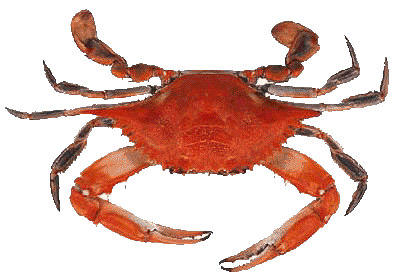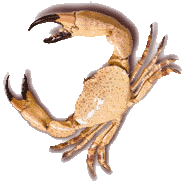|
NORTH CAROLINA CRABBING REGULATIONS License:
None required for the following method of crabbing
Regulations may change, so we suggest that you check with North Carolina Department of Environment and Natural Resources before crabbing. BLUE CRAB
Ocracoke waterways are heavily populated with the Atlantic Blue Crab. Very easy to catch and requiring inexpensive gear, crabbing is an activity the entire family can enjoy. Unlike fishing, crabs are always "biting", (or "clawing" ).
Equipment
Required:
Where and When To Go
The best places are likely around boat landings, little tidal creeks, or anywhere there is an open space around salt water. Piers and docks are fine too. You don't need a boat, just stand on the bank. The best times are near low tide (or what the crabbers call ebb tide) day or night. The crabs are close to the shoreline and actively feeding. What To Do
Tie the weight to one end of the string. Tie the bait next to the weight (wrap the string around the bait tightly and tie a knot). Tie a stick to the other end. How to Do It Throw out the bait and wait until you feel a little tug or "pulling" on the string. Then, slowly ... pull in the bait, in a steady motion. The crab will hang on until it is almost on shore. When you can begin to see it, scoop the crab up into the net from behind (where the crab can't see the net coming). It may take a few lost crabs to get the hang of it. Once netted, dump the crab into the bucket and get ready for the next one. If you are only going out for a few hours, no water is required in the bucket.
How To Cook
Grab a big pot
and fill it about 1/2 to 3/4 full of water. Bring to a full boil. Season the water as desired. Crab Boil season works well or try some lemon pepper. While the water boils, place the crabs into the pot.. Allow to boil until the crabs turn red. That's it. Don't overcook!
Be very careful handling the crab. A long pair of pliers or barbecue or salad tongs work best. Spines on the sides of the shell are pin sharp. They can be very painful.
How To Crack & Eat
Here's the messy part ... getting to the meat ... definitely an outside or big sink job. Break the shell in half, then separate the top shell. The meat is white and found towards the sides near the legs. Pull the meat out and place in a bowl, being careful not to get any of the black or gray stuff mixed in with the white meat. (The black stuff is the lung and cannot be safely eaten.) Then, break open the claws and retrieve all the meat. The rest will come naturally ... ENJOY!
STONE CRAB
-- Different Rules Apply!
Now and then,
you will catch a different looking crab... a crab that is reddish
brown in color with HUGE mean looking claws ... the Stone Crab. Sorry, you can NOT keep him! But, you can take one claw (provided he has two) and it must be the largest one. It's state law! The claw is definitely worth taking as it is a special treat. And, the crab will regenerate another claw to replace the lost one. To remove the claw, gently pin the crab to the ground with your foot (but don't crush him). Grab the claw with a stiffly gloved hand or long-handled pliers and twist the claw off at the body. Release the crab back to the water. Prepare the same as Blue Crabs.
or click HERE to visit Ocracoke Cottages |


